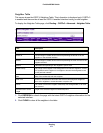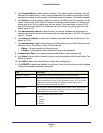
Routing
280
ProSafe M5300 Switch
VRRP
The Virtual Router Redundancy protocol is designed to handle default router failures by
providing a scheme to dynamically elect a backup router. The driving force was to minimize
“black hole” periods due to the failure of the default gateway router during which all traffic
directed towards it is lost until the failure is detected. Though static configuration of default
routes is popular, such an approach is susceptible to a single point of failure when the default
router fails. VRRP advocates the concept of a “virtual router” associated with one or more IP
Addresses that serve as default gateways. In the event that the VRRP Router controlling
these IP Addresses (formally known as the Master) fails, the group of IP Addresses and the
default forwarding role is taken over by a Backup VRRP Router.
From the VRRP link, you can access the following pages:
• Basic on page 280
• Advanced on page 282
Basic
From the Basic link, you can access the following pages:
• VRRP Configuration on page 280
VRRP Configuration
Use the VRRP Configuration page to enable or disable the administrative status of a virtual
router.
To display the VRRP Configuration page, click Routing VRRP Basic VRRP
Configuration.
To configure the global VRRP settings:
1. VRID is only configurable if you are creating new Virtual Router, in which case enter the
VRID in the range 1 to 255.
2. Use Interface to select the Unit/Slot/Port for the new Virtual Router from the pull-down
menu.


















